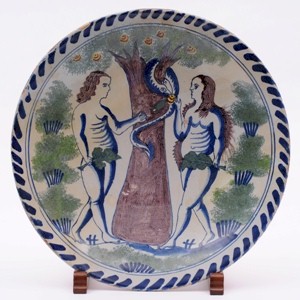
An Adam and Eve delft charger, probably London delft, circa 1720-40 (FS17/105), from the Tryhorn Collection, which sold for £1,300 in January 2013.
The story of Adam and Eve being tempted by the serpent is an iconic one, so it is little surprise that it was a popular motif on English delft chargers from 1635 until well into the 18th century with eleven different schemes from five variations being recorded.
Made primarily in London and Bristol, it has been suggested that one could tell which delftware was which by the blue dashes on the borders - those produced in London were said to be painted at a 45 degree angle and dashes from the Westcountry were said to be blobby or tapering in form.
The two most popular designs on English delft are taken from engravings of Adam and Eve by Pierre Lombart (see the image above for an example that uses this as it's inspiration) and Crispin de Passe (see the image below). Whilst they were certainly not a detailed and faithful copy of their source prints, the robust and rather naïve brush and sponge work on these delft chargers is part and parcel of their charm.

An Adam and Eve delft charger, Bristol, circa 1740, which will be offered for auction in our July 2013 Fine Sale (FS19/393).
London Delft and Bristol Delft may not have the benign 'perfection' of porcelain but instead evidence the hand of their makers in every sweep of the brush. Certainly Adam and Eve delft chargers from either London or Bristol have an increasingly painterly and perhaps 'rushed' feel about them as the 18th century progressed.
However, to consider delft from either city as peasant pottery would be wholly wrong as these English delft Adam and Eve chargers were desirable status symbols and although they are dishes, they were not for utilitarian purposes, but for display.
- Bearnes Hampton & Littlewood
- Delft Auctions
- English Delft
- London Delft
- Bristol Delft
- Adam and Eve Chargers
- Delftware






